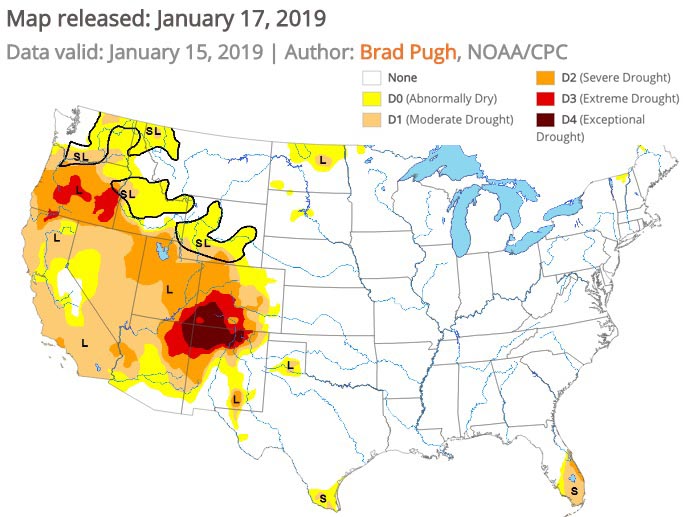
Today the wildfire danger was “elevated” or “critical” in parts of New Mexico, Arizona, and Texas according to the National Weather Service’s Storm Prediction Center.
Historically the spring wildfire season in New Mexico and Colorado begins in May, but in recent years large fires have occurred earlier. Last year on March 8 the Stateline Fire started that burned over 28,000 acres in New Mexico, Colorado, and Oklahoma.
As the threat from wildfires increases into the new year I can’t help but wonder how the shutdown of the Departments of Agriculture and Interior will affect the suppression of wildfires. We already know that many meetings and important firefighter training sessions have been canceled, hiring of seasonals is affected, and little to no fuel management activities are being conducted to reduce the threats to private property in spite of criticism from the White House about inadequate forest management leading to large wildfires.

Some of the more than than 10,000 wildland firefighters in those departments are still working but without pay. Others are furloughed, also without pay.
In addition to those dedicated firefighters, the “militia”, made up of non-fire federal employees who are certified to fight fire when needed, are furloughed. When large fires break out the militia is called upon to fill many of the operational and logistical roles necessary to manage and suppress a fire. Contractors are also called in to provide essential services on fires including fire crews, engines, dozers, water tenders, medics, air tankers, helicopters, generators, catering, and showers. It remains to be seen to what extent these important resources will be available while there is no federal budget for the two land management departments.
I have heard a few federal firefighters say they will not fight fire for free. Unpaid firefighters working in a job that in an average year kills dozens of them raises questions about liability, safety, workman’s compensation, availability of emergency medivac services, and medical care.
The federal agencies already attempt to fight fire on the cheap. With unpaid personnel and no funding, will that degrade even further?
Firefighters are dedicated professionals and routinely go above and beyond the call of duty to protect lives and property. Most of them love what they are doing but could make much more money in a conventional, less hazardous job. At the entry level in the federal government they only make a little more than minimum wage. Years later they may still be living paycheck to paycheck. But when it can appear that they have been hung out to dry due to a petty political snit thousands of miles away in D.C., it may cause them to rethink what, if anything, they owe to the federal agency that is ordering them to work while not being paid.
Now that they all have missed a paycheck and next week will miss a second one, at some point they will have to make a choice about continuing to work for no money, or, to support themselves and their families — should they find another job that actually pays them to work, temporarily or for the long term.
Below is the Drought Monitor showing most areas in the western states in drought status ranging from Abnormally Dry to Exceptional Drought. The temperature and precipitation outlooks for February, March, and April predict higher than average temperatures in all of the western states for the next three months. These conditions, if proven accurate, could lead to higher than normal wildfire activity. But the actual conditions during that period, including wind speed, precipitation, and humidity, are also very important.



On our local Forest, personnel have been down staffed to 11 per District ( 1 BC, 1 Patrol and 1 Engine) and ONLY responding to brush fires.
What about support units? Incident Management Teams and ALL that they come with.
Contractors? This year is a new contract year for different applications.
When will these contractors have their equipment inspected for pre-season.
A lot of questions that need some answers quickly.
Looks like the Lincoln’s already having to deal with a new start per nmfireinfo